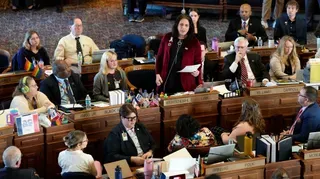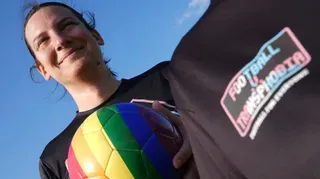November 29, 2007
Why HIV/AIDS Continues to Grow in Ethnic/Minority Communities
David Foucher READ TIME: 6 MIN.
Nearly three decades into the AIDS epidemic after hard fought advances in prevention and treatment, disturbing news is now surfacing that the U.S. Centers for Disease Control & Prevention is preparing to release over the next few months alarming statistics regarding the new rate of HIV/AIDS infections in America.
Several sources closely connected to the CDC including AIDS advocacy and prevention organizations have revealed that over a 12 month period in 2006, there have been as many as 60-63,000 new cases of HIV reported. This number is up dramatically from the longstanding 40,000 new infections a year statistic that has been estimated by the CDC for the past decade.
Some of the reasons cited for the huge increase range from the overall increase in HIV testing to more accurate HIV reporting by state agencies. But what's even more dramatic about these numbers is that a disproportionate percentage of the new diagnosed cases reside in people of color communities, thus highlighting a growing concern that HIV messages of prevention are not effectively reaching minority communities.
The numbers are staggering: While Blacks consist of 13% of the general population, they comprise a stunning 49% of new diagnosed cases of HIV/AIDS. While Latinos consist of 14% of the general population they comprise 18% of new diagnosed cases of HIV/AIDS. Between 1999 and 2003, HIV/AIDS diagnoses among the Asian Pacific Islander community increased by 34%. Native Americans/Alaska Natives comprise less than 1% of HIV/AIDS reported cases, but their AIDS incident rate is higher than that of white, non-Hispanics.
What the Experts Have To Say
With at least 20 years worth of HIV education and public awareness campaigns highlighting safer sex practices, why is it that communities of color continue to increase in their new HIV infection rates? What exactly isn't working and what barriers still exist for these communities respectively?
Rudy Carn, executive director of the National AIDS Education and Services for Minorities (NAESM), believes that "homophobia, decreased funding and resources to effectively implement strategies that work, plus a lack of research and studies that focus on unique issues pertaining to communities of color" have collectively impeded progress in providing an effective HIV preventative message.
But Dr. Ron Simmons, president of Us Helping Us, one of the largest nonprofit black AIDS organizations in the nation, goes even further.
"The two biggest barriers are the stigma of HIV and homophobia," he explains. "That coupled with the fact that we don't want to talk about sex frankly, honestly and openly. You come to this impasse if you start talking about it."
However, from a Latino perspective the barriers are complicated by additional social concerns.
Francisco J. Lazala of the Latino Commission on AIDS explains that a "lack of adequate health care including mental health services, homophobia and heterosexism, and insecurities related to immigration status," also serve as barriers of HIV education and outreach.
"In general, an HIV prevention message is obscured for everyone because of the federal government's fixation with abstinence," he added.
Within the Asian community, Ravinia Hayes-Cozier, director of government relations and public policy for the National Minority AIDS Council (NMAC) explains that Asians are "very monolith... even more so when you look at other cultures. They tend to be probably more conservative. There are a lot of do's and don'ts and then sometimes they can ostracize folks from their communities, really to the extent they're just taboo subjects and they're just not talked about. It's not about doing the behavior but its not talking about the behavior."
Meanwhile, the Native American community has its own distinct set of challenges in terms of HIV prevention.
According to Warren Jimenez, executive director of the National Native American AIDS Prevention Center (NNAAPC), "Awareness and stigma in Indian Country are real issues. Indian Country is very diverse. Depending on which tribe a person comes from, depends on the levels of acceptance of discussing issues of sexuality. As a result, it could make it very difficult to discuss HIV."
Additionally, the Centers for Diseases Control spokesperson, Jennifer Ruth, gives her own laundry list of reasons why communities of color are disproportionately more at risk for HIV/AIDS infection.
"Some at-risk individuals are experiencing prevention burn-out after 25 years of HIV prevention efforts," she explains. "There is a new generation that needs to be reached with HIV education and prevention. African Americans face high rates of STDs, which may help facilitate HIV transmission and black MSM may face stigma, which may limit their access to prevention services, increasing their risk of HIV infection."
Ruth also added that other racial and ethnic communities also face similar HIV prevention challenges.
"Poverty, limited access to health care, limited access to testing and treatment and language barriers may all contribute to the vulnerability of Latinos to HIV."
What's Being Done?
Although minority communities are being disproportionately impacted by HIV/AIDS, there is an aggressive ongoing effort underway to stem the tide, explains Lazala.
"There has been a considerable amount of grassroots organizing and information in order to overcome some of the social and linguistic barriers," Lazala says. "But economic barriers including poverty and lack of insurance have been harder to overcome."
Meanwhile, in black communities, more creative initiatives are being developed to target black straight identified people where they socially congregate and interact, such as the Us Helping Us, "Barbershop/Beauty Parlor" outreach program.
In addition to this initiative, Simmons says "some [black] churches have become more progressive in talking about HIV. We have found that more churches are willing to work with us around testing at their churches and around doing education for their congregations."
In fact, his organization hosts an annual Black Mother's Day gospel celebration and an AIDS Awareness Day in conjunction with several black churches.
"Slowly people are beginning to wake up. Not everybody but some people," he cautions.
Within the Native American community, in 2006, NNAAPC, along with other partners, organized the first National Native American HIV Awareness Day.
"According to evaluations from the Center for Disease Control, it was the most successful initial awareness day that has been sponsored by the CDC," Jimenez adds. "For 2008, we hope to build on this momentum to increase awareness of HIV in Indian Country."
NNAAPC has also developed several awareness and anti-stigma social marketing campaigns targeting Native American, Alaskan Native and Native Hawaiians.
Improving the Government's Response to HIV/AIDS Education/Outreach to Communities of Color
The federal government's lack of cultural competency around HIV has been a longstanding contention in its efforts to prevent the spread of HIV in communities of color. Minority AIDS experts all agree that more can done and that more should be done to create a diverse and inclusive outreach strategy.
"To save communities of color from this deadly epidemic, the government must recognize that not all communities of color are the same and that HIV prevention strategies must not also be the same," sates Carn.
In addition, Lazala adds that "the government should allow grassroots and community based organizations to decide how best to present information in a manner that would be linguistically, socially and culturally effective."
According to Hayes-Cozier, "it may be time for us in the AIDS community as well as at the federal level to begin really looking and talking about conditions of poverty and education and some of the social justice issues that people can relate more to because they are so absorbed in it.
"When you talk about an individual condition like HIV/AIDS people begin to put faces, names, and labels, and somehow in those faces, names and labels they take themselves out of the process."
Further, Simmons feels "the government should be doing everything it can to lessen the stigma of HIV as well as homophobia. It should be willing to spend the money freely particularly in areas like the rural parts of the south or other parts of the country where you don't have municipal health departments putting in millions of dollars towards prevention."
He jokingly adds that once the federal government begins spreading HIV preventative messages across the country the way that McDonalds promotes its Happy Meals while funding the entire initiative with money allocated for three B-52 bombers, only then will there be substantial decreases in the rate of new HIV/AIDS infections.
David Foucher is the CEO of the EDGE Media Network and Pride Labs LLC, is a member of the National Lesbian & Gay Journalist Association, and is accredited with the Online Society of Film Critics. David lives with his daughter in Dedham MA.






